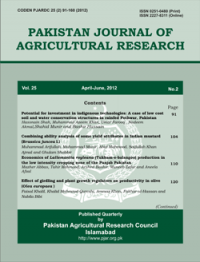PREDATORY APTNESS OF ANTS AGAINST RED FLOUR BEETLE, TRIBOLIUM CASTANEUM HERBST (TENEBRIONIDAE: COLEOPTERA) IN WHEAT FLOUR
Farid Asif Shaheen*, Sadia Parveen*, Ahmed Zia**, Ghulam Qadir*,
Mureed Husain*** and Rifat Ullah Khan****
ABSTRACT
The red flour beetle (RFB), Tribolium castaneum is one of the most destructive pests of stored grains and other food products including wheat flour. Due to its severe infestation, the flour gets mouldy, turns yellowish, gets pungent odour and becomes unhealthy for human consumption. The infested samples of wheat flour by T. castaneum were collected from different localities and its culture was maintained in laboratory. Three ant species namely, Dorylus labiatus, Camponotus rufipes and Monomorium minimum were collected from forest and non-forest habitats and compared for their predation against different life stages of RFB. Results showed D. labiatus of forest habitat as an efficient pupal predator that consumed 91.66% pupae of RFB. It was significantly different from non-forest ant population and control with 73.33% and 11.66% pupal predation, respectively. C. rufipes from forest habitat showed maximum adult predation (25%), which was significantly higher than non-forest ant population and control jar with 15% and 3.33% adult predation, respectively. The forest population of M. minimum exhibited 56.66% larval predation that was significantly different from non-forest population with 41.66% larval consumption. Pupal stage was the highest vulnerable stage to the ant predation and was extremely predated by D. labiatus collected from forest habitats. The lowest predation was observed at larval stage by forest population of M. minimum (1.66%) that was significantly different from all the susceptible stages of RFB. These results indicate that ants could be used as biological control agents against RFB.
To share on other social networks, click on any share button. What are these?







